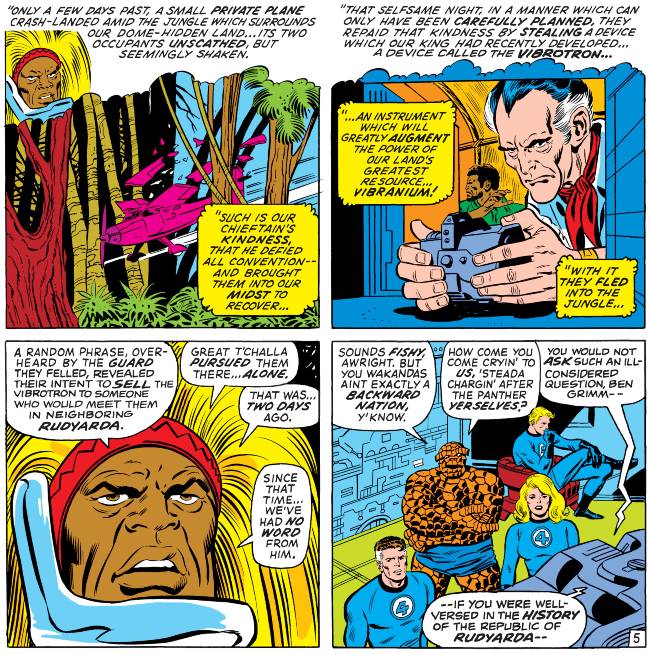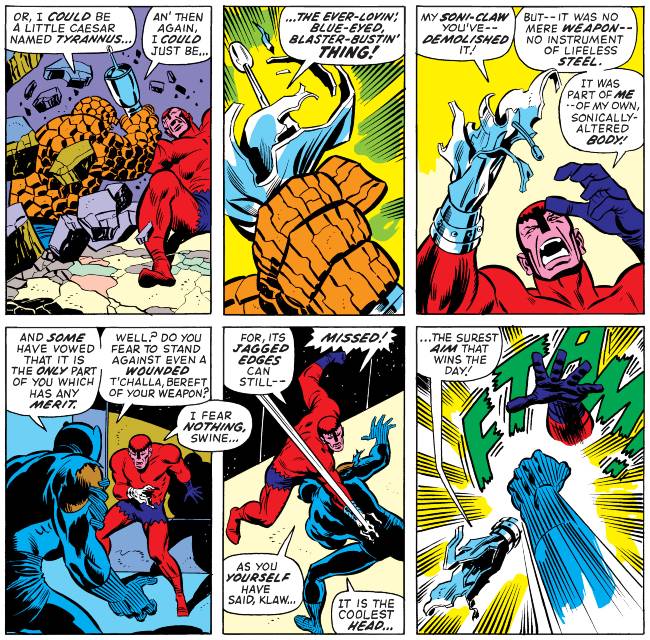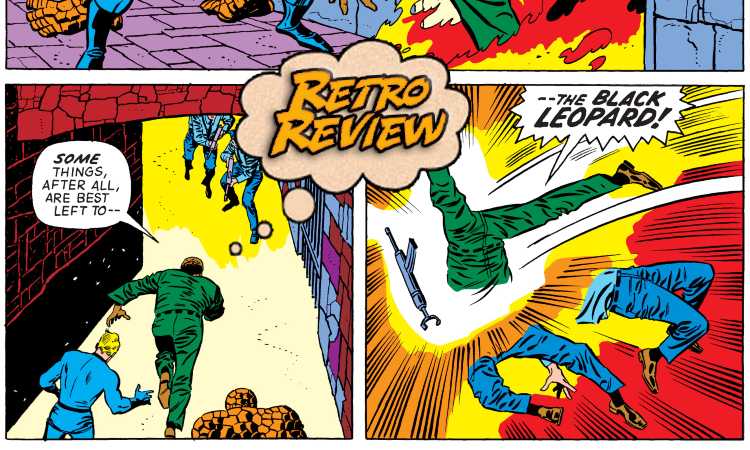It’s well-documented that King T’Challa predates, if only barely, the political group that also calls themselves The Black Panthers. But have you heard about the time they tried to address it in the comics? Your Major Spoilers Retro Review of Fantastic Four #119 awaits!
 FANTASTIC FOUR #119
FANTASTIC FOUR #119
Writer: Roy Thomas
Penciler: John Buscema
Inker: Joe Sinnott
Colorist: Uncredited
Letterer: Artie Simek
Editor: Stan Lee
Publisher: Marvel Comics
Cover Price: 20 Cents
Current Near-Mint Pricing: $50.00
Release Date: November 23, 1971
Previously in Fantastic Four: Debuting in 1966 as Marvel’s first Black superhero, T’Challa of Wakanda was a trailblazer, in more ways than one. It is often claimed that The Black Panther is the first EVER Black superhero, but that’s a claim that has to come with more than a few asterisks. The official founding of the Black Panther Party, a counterculture political group espousing Black Power came in October of that same year, and the Black Panthers achieved nationwide infamy after a series of protests and interactions with law enforcement. By 1969, the head of the FBI branded the Panthers as the greatest threat to the security of the United States. By 1971, the controversy was such that Stan Lee directed Roy Thomas to change his name to Black Leopard, and while Roy wasn’t a fan, he obeyed the editor-in-chief.
After a few pages of The Human Torch and The Thing having one of their characteristic spats, resulting in the consternation of Mister Fantastic and a lot of property damage at the Baxter Building, a distress call comes in… from Wakanda!
 That the Black Panther has gone missing is bad enough, but that he was last seen in the white supremacist stronghold of Rudyarda, which seems to be a stand-in for apartheid-era Namibia or South Africa. Which country it is meant to represent is less important than the fact that Ben and Johnny are going to go there. (Reed and Sue are busy cooking up something to make it possible for Crystal to live among the humans again, ending the Torch’s separation from his lady-love.) After a commercial flight and an attempted skyjacking, Messrs. Grimm and Storm arrive in Rudyarda to begin their investigation. Discovering that the King of Wakanda is being held in the local jail, the Fantastic Two decide to handle things superhero-style, busting T’Challa out with a little stone strength and a little pyrokinetic fury.
That the Black Panther has gone missing is bad enough, but that he was last seen in the white supremacist stronghold of Rudyarda, which seems to be a stand-in for apartheid-era Namibia or South Africa. Which country it is meant to represent is less important than the fact that Ben and Johnny are going to go there. (Reed and Sue are busy cooking up something to make it possible for Crystal to live among the humans again, ending the Torch’s separation from his lady-love.) After a commercial flight and an attempted skyjacking, Messrs. Grimm and Storm arrive in Rudyarda to begin their investigation. Discovering that the King of Wakanda is being held in the local jail, the Fantastic Two decide to handle things superhero-style, busting T’Challa out with a little stone strength and a little pyrokinetic fury.
 Here’s the part that’s interesting, though. T’Challa calls himself The Black Leopard when he breaks free, leading to a rather brief conversation about the connotations now attached to “Black Panther.” From a scientific taxonomical standpoint, it actually is a very minor change, as the panther is literally the name for black-furred variants of the leopard and the jaguar. After the first hundred-plus issues were drawn by Kirby, it’s interesting to see John Buscema’s take on the Four and the
Here’s the part that’s interesting, though. T’Challa calls himself The Black Leopard when he breaks free, leading to a rather brief conversation about the connotations now attached to “Black Panther.” From a scientific taxonomical standpoint, it actually is a very minor change, as the panther is literally the name for black-furred variants of the leopard and the jaguar. After the first hundred-plus issues were drawn by Kirby, it’s interesting to see John Buscema’s take on the Four and the Panther Leopard. At this point, the artist had been working regularly for twenty-five years, and it’s hard for me to tell if he’s intentionally keeping elements of Jack’s visuals or if this is just where he is in his career. It’s much different than his wonderful run on The Avengers when I was a teenager, but the power in his figure work is the same. As our trio of heroes seek T’Challa’s stolen vibranium device, we find that the man behind the whole scheme is a familiar face to our renamed hero.
 This issue also makes what I believe to be the first connection between Black Leopard’s Wakandan vibranium and the Savage Land metal which appeared the year before. Generally known as “anti-metal,” Savage Land vibranium is the primary weapon of Ka-Zar’s evil brother, The Plunderer. It’s kind of neat to see that kind of continuity-knitting, but then again, this issue’s writer is the man who coined the term “retcon.” As for Klaw, his sonic might has proven up to the task of battling Black Leopard, and even bringing down The Human Torch.
This issue also makes what I believe to be the first connection between Black Leopard’s Wakandan vibranium and the Savage Land metal which appeared the year before. Generally known as “anti-metal,” Savage Land vibranium is the primary weapon of Ka-Zar’s evil brother, The Plunderer. It’s kind of neat to see that kind of continuity-knitting, but then again, this issue’s writer is the man who coined the term “retcon.” As for Klaw, his sonic might has proven up to the task of battling Black Leopard, and even bringing down The Human Torch.
But The Thing is another kettle of orange, rocky fish.
 The king has been liberated, the device that would allow weaponized vibranium is destroyed in the explosion of Klaw’s escape craft, and the villain is laid low by a left hook from his enemy. But before the heroes can enjoy their win, the Rudyardan police arrive and ever-so-carefully try to tell The Black Leopard that he’s not allowed to be out in this part of town after dark.
The king has been liberated, the device that would allow weaponized vibranium is destroyed in the explosion of Klaw’s escape craft, and the villain is laid low by a left hook from his enemy. But before the heroes can enjoy their win, the Rudyardan police arrive and ever-so-carefully try to tell The Black Leopard that he’s not allowed to be out in this part of town after dark.
Once again, Mama Grimm’s blue-eyed boy changes the conversation in a way that only he can.
 It’s very interesting to see that an issue that attempted to change Black Leopard’s name because it might be controversial ending with a big slightly goofy moment of anti-racism, but the shattering of the separate-but-in-no-way-equal doors is pretty satisfying. All in all, though, Fantastic Four #119 is a pretty okay issue from a run of Fantastic Four that suffers from some serious doldrums, and while that big last moment is cool, there’s a lot of silliness in the ideas herein, earning 3 out of 5 stars overall.
It’s very interesting to see that an issue that attempted to change Black Leopard’s name because it might be controversial ending with a big slightly goofy moment of anti-racism, but the shattering of the separate-but-in-no-way-equal doors is pretty satisfying. All in all, though, Fantastic Four #119 is a pretty okay issue from a run of Fantastic Four that suffers from some serious doldrums, and while that big last moment is cool, there’s a lot of silliness in the ideas herein, earning 3 out of 5 stars overall.
This issue is the only time that T’Challa used the Black Leopard name was used, which may have something to do with the fact that, by the end of 1972, Roy Thomas would succeed Stan Lee as Marvel EIC. After a few appearances where he used neither alias, King T’Challa joined the Mighty Avengers in Avengers #105, declaring himself to be The Black Panther once more. Writer Steve Englehart even took the time to call out the name change as foolish in dialogue, but it’s proven that what Stan Lee wants, Stan Lee gets.
Ask me about Iron Man’s nose sometimes.
Dear Spoilerite,
At Major Spoilers, we strive to create original content that you find interesting and entertaining. Producing, writing, recording, editing, and researching requires significant resources. We pay writers, podcast hosts, and other staff members who work tirelessly to provide you with insights into the comic book, gaming, and pop culture industries. Help us keep MajorSpoilers.com strong. Become a Patron (and our superhero) today.
FANTASTIC FOUR #119
Thomas' script is kind of inconsistent and overloaded, but the antiracist message still holds water, and the attempted renaming makes it interesting from a historical perspective.
-
Writing5
-
Art7
-
Coloring6


